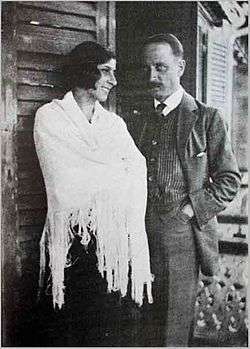Baladine Klossowska

Baladine Klossowska or Kłossowska (born in 1886 as Elisabeth Dorothea Spiro, died in 1969) was a European painter. She was the mother of the artist Balthus[1] and the writer Pierre Klossowski,[2] and the last lover of the poet Rainer Maria Rilke.[3]
She was born Elisabeth Dorothea Spiro in Breslau, Prussia (now Wrocław, Poland) to a Jewish family; her father, Abraham Beer Spiro, was a cantor, who moved his family from Korelichi in Novogrudok district of Minsk Governorate to Breslau in 1873.[4][5][6] In Breslau, he was appointed a Chief cantor of the White Stork synagogue (Synagoga pod Białym Bocianem) — one of the two main synagogues of the city.[7][8][9]
She married the painter and art historian Erich Klossowski; the couple moved to Paris, where their sons were born — Pierre in 1905 and Balthasar in 1908. Elisabeth Spiro Klossowski pursued her own artistic career under the name Baladine Klossowska; she preferred life in France and lived there through much of her later life.
The Klossowskis were forced to leave France in 1914, at the start of World War I, due to their German passports. The couple separated permanently in 1917; Klossowska took her sons to Switzerland. They moved to Berlin in 1921 due to financial pressures.[10] Mother and sons returned to Paris in 1924, where the three lived a materially marginal existence, often dependent upon help from friends and relations.
Klossowska met Bohemian-Austrian poet Rainer Maria Rilke (1875-1926) in 1919. At the time, Rilke was emerging from a severe depression that had kept him from writing for several years during and after World War I. The two pursued an intense but episodic romance that lasted until Rilke's death from leukemia in 1926. During this time, Rilke had written in what he called "a savage creative storm" his two most important collections of poetry, the Duino Elegies and Sonnets to Orpheus, both published in 1923. During their romance, Rilke called Klossowska by the pet name "Merline" in their correspondence—first published in 1954.[11][12]
References
- ↑ Jean Clair, Balthus, London, Thames & Hudson, 2001.
- ↑ Anthony Spira and Sarah Wilson, Pierre Klossowski, Ostfildern, Germany, Hatje Cantz, 2006.
- ↑ Ralph Freedman, Life of a Poet: Rainer Maria Rilke, Evanston, IL, Northwestern University Press, 1998.
- ↑ http://www.britannica.com/EBchecked/topic/50921/Balthus
- ↑ Charles A. Riley, Aristocracy and the Modern Imagination (p. 207)
- ↑ Sabine Rewald, Balthus (p.11)
- ↑ Marmor, Prunk und große Namen
- ↑ Peter Spiro «Erinnerungen»
- ↑ Stary Cmentarz Żydowski we Wrocławiu
- ↑ Edward Lucie-Smith, Lives of the Great Twentieth Century Artists, New York, Rizzoli, 1986; p. 299.
- ↑ Rainer Maria Rilke, Baladine Klossowska, Correspondence 1920–1926, Zurich, 1954.
- ↑ Rainer Maria Rilke, Letters to Merline, 1919–1922, St. Paul, MN, Paragon House, 1989.
External links
- A 1923 photograph of Klossowska and Rilke
- Klossowska's 1925 sketch of Rilke
- Eugen Spiro's portrait of his sister
|